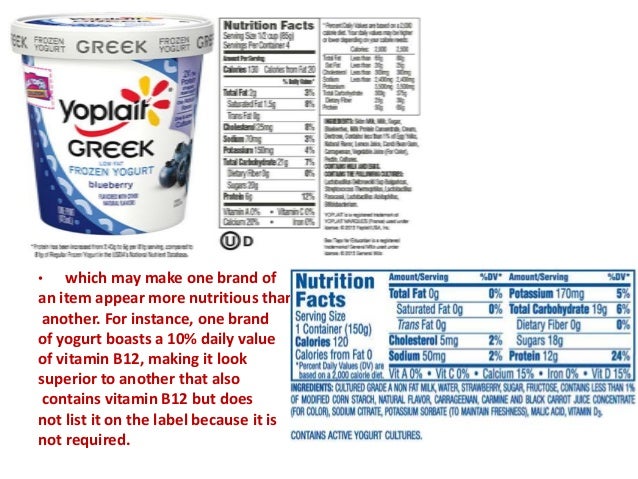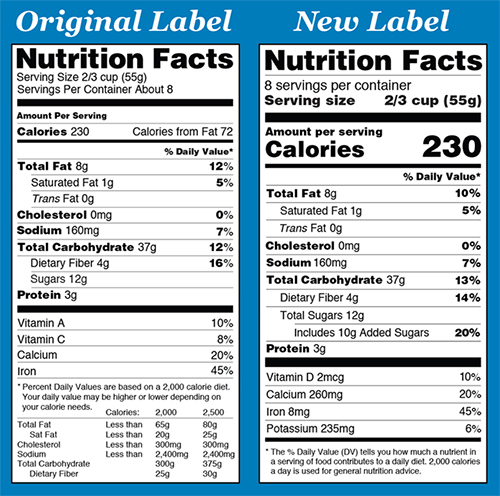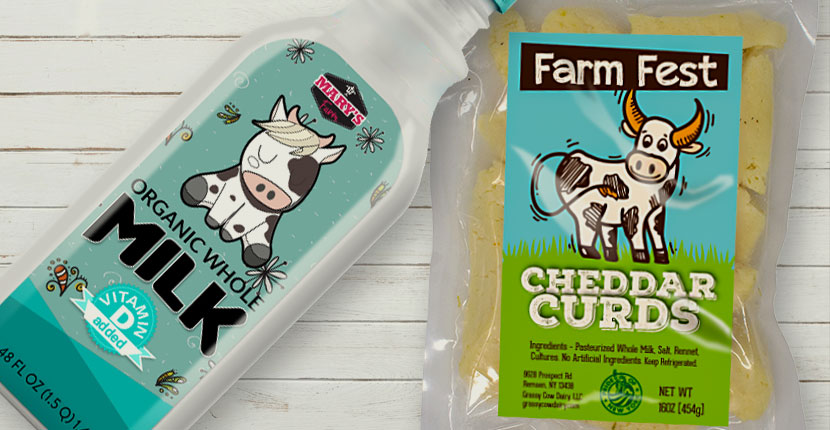45 nutrient content claims on food labels
Status of Nutrition Labeling, Health Claims, and Nutrient Content ... The Food and Drug Administration (FDA) conducts studies of food labels as part of its ongoing monitoring of the nutritional status of the US population. In 1994 FDA nutrition labeling rules were implemented and in 1997 the Food Label and Package Survey characterized various aspects of the labeling o … Label Claims for Food & Dietary Supplements | FDA Mar 07, 2022 · Among the claims that can be used on food and dietary supplement labels are three categories of claims that are defined by statute and/or FDA regulations: health claims, nutrient content claims ...
Nutrient content claims - LII / Legal Information Institute (b) A claim that expressly or implicitly characterizes the level of a nutrient of the type required to be in nutrition labeling under § 101.9 or under § 101.36 (that is, a nutrient content claim) may not be made on the label or in labeling of foods unless the claim is made in accordance with this regulation and with the applicable regulations ...
Nutrient content claims on food labels
Nutrient Claims on Food Labels | Home & Garden Information Center Sodium content cannot exceed 360 mg per serving for individual foods and 480 mg per serving for meal-type products. If a food is labeled "healthy" or makes a health claim, it cannot contain any nutrient that increases the risk for disease. It must contain no more than 20% of the DV per serving of total fat, saturated fat, cholesterol, or sodium. Understanding Food Labels | The Nutrition Source | Harvard T.H. Chan ... Under the Food Allergen Labeling and Consumer Protection Act of 2004, eight major food allergens—milk, fish, tree nuts, peanuts, shellfish, wheat, eggs, and soybeans—are required to be listed in a "contains" statement near the Ingredients list if present in a food. An example would be "contains wheat, milk, and soy." how to understand food labels - Eat For Health how to understand food labels What to look for… Don’t rely on health claims on labels as your guide. Instead learn a few simple label reading tips to choose healthy foods and drinks, for yourself. You can also use the label to help you lose weight by limiting foods that are high in energy per serve. 100g Column and Serving Size
Nutrient content claims on food labels. CFR - Code of Federal Regulations Title 21 - Food and Drug ... Mar 29, 2022 · (b) Label statements that are not implied claims. Certain label statements about the nature of a product are not nutrient content claims unless such statements are made in a context that would make them an implied claim under § 101.13(b)(2). The following types of label statements are generally not implied nutrient content claims and, as such ... eCFR :: 21 CFR 101.54 -- Nutrient content claims for "good source ... (B) Quantitative information comparing the level of the nutrient in the product per labeled serving with that of the reference food that it replaces (e.g., "Fiber content of white bread is 1 gram (g) per serving; (this product) 3.5 g per serving") is declared adjacent to the most prominent claim or to the nutrition label, except that if the ... Nutrient Claims on Food Labels - Truly Good Foods Nutrient Claims on Food Labels July 19, 2018 Nutrient claims describe the content of a food, including the amount of nutrients, calories, cholesterol or fiber, but not in exact amounts. Usually on the front of the food label, the nutrient claim provides a quick comparison between similar products. Label Claims for Conventional Foods and Dietary Supplements Nutrient Content Claims The Nutrition Labeling and Education Act of 1990 (NLEA) permits the use of label claims that characterize the level of a nutrient in a food (i.e., nutrient content claims)...
Structure/Function Claims | FDA Mar 07, 2022 · Final Rule: Food Labeling: Nutrient Content Claims, Health Claims, and Statements of Nutritional Support for Dietary Supplements (62 Fed. Reg. 49859 at 49863-49866) Conventional Foods History of Nutrition Labeling - Front-of-Package Nutrition Rating ... Nutrients to be listed on nutrition labels included calories, calories from fat, total fat, saturated fat, cholesterol, sodium, total carbohydrate, dietary fiber, sugars, protein, vitamins A and C, calcium, and iron. Reading Food Labels (for Parents) - Main Line Health Food labels provide nutrition information so you can make smart choices about the food you buy and serve your family. The U.S. Food and Drug Administration (FDA) and the U.S. Department of Agriculture (USDA) require labels on almost all packaged foods. The information usually is on the back or side ... Use of the Term Healthy on Food Labeling | FDA While FDA is considering how to redefine the term "healthy" as a nutrient content claim, food manufacturers can continue to use the term "healthy" on foods that meet the current regulatory...
Nutrient Content - an overview | ScienceDirect Topics A nutrient content claim either expressly or implicitly characterizes the level of a nutrient in a product (e.g., "high in vitamin C" or "low in sodium"). In general, nutrient content claims cannot be used in food labeling unless the claim is made in accordance with existing FDA regulations or an authoritative statement by a scientific body. Regulating health claims on food labels using nutrient profiling: what ... Objective: Proposed Australian regulation of claims on food labels includes requirements for products carrying a health claim to meet nutrient profiling criteria. This would not apply to nutrition content claims. The present study investigated the number and healthiness of products carrying claims and the impact of the proposed regulation. Understanding Food Labels and Health Claims - Nutrition Essentials This label is called a Nutrition Facts panel, which gives information on the number of servings per container, the number of calories per serving, and certain nutrients. Specifically, it lists the macronutrients and four of the most important micronutrients people need to pay special attention to, such as Vitamin D, Calcium, Iron, and potassium. Nutrition content claims and health claims - Food Standards Nutrition content claims are about the content of certain nutrients or substances in a food, such as 'low in fat ' or 'good source of calcium'. These claims need to meet certain criteria. For example, food with a 'good source of calcium' claim needs to contain at least the amount of calcium specified in the Standard. Health claims
Food Packaging Claims | American Heart Association "Nutrient content claims" are used for two purposes: To describe the level of a nutrient in the product using terms such as free, high, and low or To compare the level of a nutrient in a food to another food using terms such as more, reduced, and lite.
Nutrient Content Claims | FDA Nutrient Content Claims. See Claims That Can Be Made for Conventional Foods and Dietary Supplements for definitions of claims. Final Rule: Food Labeling: Nutrient Content Claims; Alpha-Linolenic ...
Protein Label - LabelCalc The DV for protein is 50g, so the RACC of the food must contain over 10g of protein to have the "High in Protein" nutrient content claim. To have a nutrient content claim of a food being a "Good Source of Protein" the food must contain 10-19% of the DV per RACC, or 5 to 9.5g of protein per RACC. If you would like to have your food ...
Questions and Answers on Health Claims in Food Labeling | FDA The Nutrition Labeling and Education Act of 1990 (NLEA) directed FDA to issue regulations providing for the use of health claims. All health claims must undergo review by the FDA through a petition...
The Effects of Nutrition Knowledge on Food Label Use: A Review of the ... One goal of nutrient content claims is to communicate the value or relative amount of a specific nutrient within a food product (e.g., good source of fiber, fat free, low calorie). ... Petrovici D, Fearne A, Nayga RM, Drolias D. Nutritional knowledge, nutritional labels, and health claims on food a study of supermarket shoppers in the south ...
Food Labeling & Nutrition | FDA Food labeling is required for most prepared foods, such as breads, cereals, canned and frozen foods, snacks, desserts, drinks, etc. Nutrition labeling for raw produce (fruits and vegetables) and...
Understanding food labels - Canada.ca Find information on food labels and how to understand them. Learn about nutrition facts tables, serving size, list of ingredients, % daily value and nutrition claims.
Nutrient Content Claims on a Food Label - LabelCalc The food product nutrition content must meet the strict guidelines and parameters set forth by the FDA in order to accurately make these nutrient content claims on a food label. For a more in-depth look at nutrient content claims, download this PDF. A Quick Reference Summary of Parameters





Post a Comment for "45 nutrient content claims on food labels"